| The Importance Of Dhyan Chand In Indian Sport |
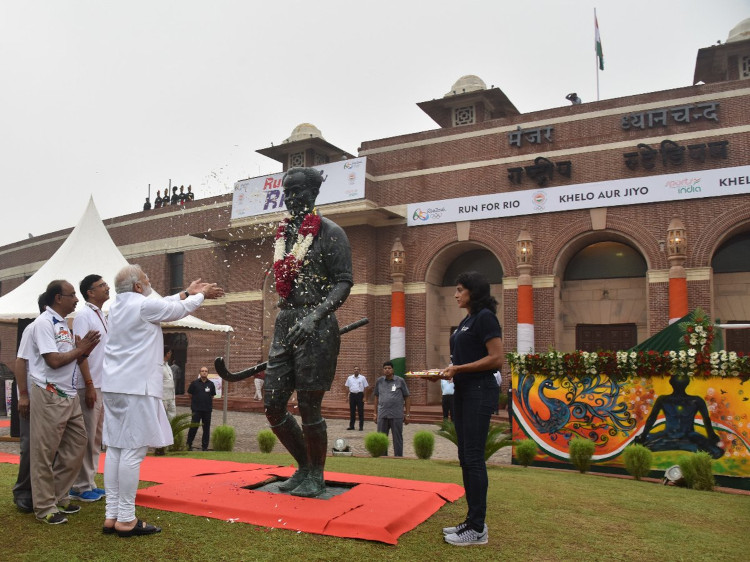
Article by Tushar Bhaduri,
courtesy The Indian
Express, File Photograph ANI
 he
Rajiv Gandhi Khel Ratna Award was renamed the Dhyan Chand Khel Ratna
Award on 6th August, 2021.
This rechristening of the country's highest sporting honour after one of
the country's legendary names could be termed political one-upmanship or
a decision that didn't come a day too soon, depending on the way one
looks at it. But what can't be denied is the emotional resonance Dhyan
Chand's name carries, and what he meant for Indian hockey, and Indian
sports in general. he
Rajiv Gandhi Khel Ratna Award was renamed the Dhyan Chand Khel Ratna
Award on 6th August, 2021.
This rechristening of the country's highest sporting honour after one of
the country's legendary names could be termed political one-upmanship or
a decision that didn't come a day too soon, depending on the way one
looks at it. But what can't be denied is the emotional resonance Dhyan
Chand's name carries, and what he meant for Indian hockey, and Indian
sports in general.
Who was Dhyan Chand?
Quite simply, he was the first superstar of hockey, and was considered
a wizard or magician of the game. He was the chief protagonist of India's three consecutive Olympic hockey gold medal
triumphs - Amsterdam 1928, Los
Angeles 1932, and Berlin 1936.
He is said to have wowed the watching
public with his sublime skills, intricate dribbling and prodiguous
scoring ability. During those tournaments, there was no team that could
compete with India, and most of the matches saw huge victory margins.
India beat hosts the Netherlands 3-0 in the 1928 Olympic hockey final, the United
States were thrashed by a scarcely-believable margin of 24-1 in the 1932
Olympic
gold medal match, while Germany went down 8-1 in the 1936 Olympic final. In
all, Dhyan Chand played 12 Olympic matches, scoring 33 goals.
What are some of the tales and anecdotes associated with
Dhyan Chand?
It is said that once his sublime skill and close control of the ball
aroused such suspicion that his stick was broken to see whether there
was a magnet inside. One has to remember that the game was played on
natural grass in those days in contrast to the astro turf now, and the
surface would often be bumpy and uneven, making ball control difficult
for lesser mortals.
During the 1936 Berlin Games, German Chancellor
Adolf Hitler, a proponent of Aryan racial superiority, was so
enamoured with Dhyan Chand's play that he offered him German citizenship
and the post of Colonel in his country's Army, an offer the Indian
ace refused.
Why does the name evoke such emotion?
Dhyan Chand played during India's pre-independence years, when the
local population was subjugated and made to feel inferior by the ruling
British. Hence, seeing an Indian dominate the Europeans in a sport
invented by them evoked a lot of pride in them.
Before Independence and for some years after that, hockey was the
only sport in which India consistently excelled at the international and
Olympic stage. In fact, between Amsterdam 1928 and Tokyo 1964, India won seven of
the eight Olympic hockey gold medals.
There were other great contemporary players, like K D Singh
'Babu', Roop Singh, and Balbir Singh Sr., but Dhyan Chand's name was always
taken first.
How has Dhyan Chand been recognised till now?
There has been a long-running campaign arguing that Dhyan Chand be
posthumously awarded the Bharat Ratna, the country's highest honour.
There was a big debate around the time of the retirement of cricketer
Sachin Tendulkar in 2013 about which sportsperson, if any, was deserving
of the accolade. Tendulkar was eventually conferred the honour, but
arguments for Dhyan Chand have continued nonetheless.
Dhyan Chand's birthday, August 29, is celebrated as National Sports Day with
the President giving away the Arjuna Awards and the other honours,
including the Khel Ratna award, now named after Dhyan Chand himself. An award for
lifetime achievement in sport is already named after him.
The Capital's
National Stadium was renamed Major Dhyan Chand National Stadium.
Why is the renaming of the Khel Ratna award on 6th August, 2021 significant?
The eight gold medals in hockey have often been termed as the
millstone around the necks of the subsequent generation of players. The
modern game is an altogether different sport from the one played in
Dhyan Chand's era. The Europeans and Australians have become much more
proficient over the decades, while the change of surface has put a
premium on fitness, speed, stamina, and physical strength.
India had not
managed to get into the top four at the Olympics since the
boycott-affected Moscow Games in 1980. The later generations may have
felt out of touch with the golden years, about which one could only read
in books or listen to in tales of the protagonists and those who
witnessed the heroics.
In that context, the performance of the Indian
men's and women's hockey teams in Tokyo can re-ignite large-scale
interest in the game. Hockey may not have a fandom like cricket, but
it's definitely followed, especially when India play a major tournament.
Renaming the Rajiv Gandhi Khel Ratna after Dhyan Chand may ensure that
the current and subsequent generations know about the original superstar
of hockey.
|
| Meet The Coach Of First Indian Hockey Team To Medal In 41 Years |

Article by Rahul Venkat. Article and photograph courtesy Olympic Channel
 he
Tokyo Olympics has been the best campaign for the Indian men's hockey
team in decades - they broke a 41-year medal drought with a bronze medal
win against Germany. he
Tokyo Olympics has been the best campaign for the Indian men's hockey
team in decades - they broke a 41-year medal drought with a bronze medal
win against Germany.
The Indian men's hockey team - winners of eight Olympic golds, one
silver and two bronze medals - had never even managed to make the
semi-finals of any Summer Olympics since 1980. It reflects significant
progress for the Indian men's hockey team and at the heart of it is
their head coach Graham Reid.
So who is Graham Reid?
A native of Queensland, Australia, Graham Reid was a former
hockey player for the Australian national team (130 international caps),
where he played as a defender and at time midfielder. He won the silver
medal with the Australian hockey team at the 1992 Barcelona Olympics and
was a part of four Champions Trophy-winning teams (1984, 1985, 1989,
1990). Graham Reid also has a bronze from the 1990 Hockey World Cup.
Intriguingly, the Australian has worked in industries as diverse as
mining and credit insurance after his playing career.
However, Graham Reid is best known for his coaching exploits. Reid's
first coaching assignment was with the Australian men's team in 2009,
when he was appointed assistant coach to the legendary Ric Charlesworth
- who had briefly served as technical advisor to the Indian hockey
teams. Graham Reid served as the assistant for five years.
When Charlesworth stepped down after the 2014 Commonwealth Games -
where Australia beat India in the final to claim their fifth gold -
Graham Reid was promoted to the top job. Reid coached Australia to the
Hockey World League Semi-final title (2015 Antwerp) and the Hockey World
League Final title (2015 Raipur). He took Australia to the 2016 Rio
Olympics - where they finished sixth after being eliminated by the
Netherlands in the quarter-finals.
Graham Reid quit the Australian team post Rio 2016 and moved to the
Dutch national men's team to work as assistant to head coach Max Caldas,
where Caldas and Reid guided the Netherlands team to the 2018 World Cup
silver medal. Reid also worked as head coach of the Amsterdam Club in
the Netherlands, for whom he had played earlier in 1993-1994.
When the Indian men's hockey team was looking for its next head coach
after the sacking of Harendra Singh in January 2019, Graham Reid was
persuaded by his former mentor Ric Charlesworth to take up the position.
The Australian was confirmed as head coach of the Indian men's team in
April 2019 and shifted based to Bengalurur, imbibing an attacking
philosophy and fast-paced style of play since he came in.
Under his tutelage, the Indian men's hockey team has risen to its
best-ever ranking of world No. 3. Graham Reid has introduced several
youngsters like Dilpreet Singh, Hardik Singh, Vivek Sagar Prasad,
Mandeep Singh and Varun Kumar into the team - all of whom have been
impressive at the Tokyo Olympics.
A first Olympic medal since 1980 is the perfect reward for the hard
work the team has put over the past two years with Graham Reid, and
hopefully, will act as a platform for more success in the coming years.
|
| Meet The Scientific Adviser To The Indian Women's Hockey Team |
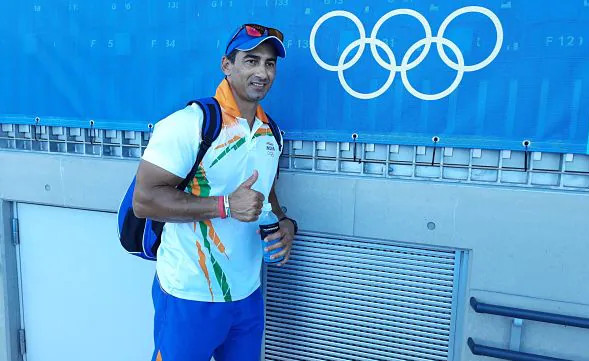
Article and photograph by Amit Kamath,
courtesy FirstPost
 ayne
Lombard, the Indian women's hockey team's scientific adviser since 2017, spoke to Firstpost
about the process that went into improving the team's fitness levels. ayne
Lombard, the Indian women's hockey team's scientific adviser since 2017, spoke to Firstpost
about the process that went into improving the team's fitness levels.
First Impressions
When I first arrived and saw the profile of the players, I thought
there is a lot of work that needs to be done. It was a process to get
them to buy in and trust me as a person first, and then looking at the
fitness side and get them to understand the process.
My approach to anything is to put them as human beings first and get
them to trust me as a person and trust the process. They understood
slowly that I worried about them as human beings, but also that I wanted
to make them better athletes.
I wouldn't take any leave. I would be in
India pretty much most of the time, taking leave once a year. Sometimes
when the rest of the team was home, I would be working with an injured
player at the SAI Bengaluru camp.
They saw that and figured that this
guy is here to actually help us. He's not here just go through the
motions. It's not just a job for him. If you show that you're working
100 percent for them, the buy-in process takes care of itself.
I wanted to empower them to make their decisions by the time I am
finished here. If they can do a gym session or a conditioning session
without me, then I know I have made them, not just fitter, but also
better athletes, who understand what they need to do as individual
athletes.
Fitter, Faster, More Agile
When I started in 2017, the one area I really had
to focus on was the physical side of
things. The girls just were not exposed to the type of training that is
required to play at the international level. The general endurance
levels (of the players) were really poor in 2017. They couldn't keep up
the intensity that is required in a hockey game to genuinely compete.
They started from a very low base. When you start
from a low base, your body adapts a lot quicker as long as you do it
smartly. This made things easier as we could progress quite quickly. But to get them from a decent level to international standards was
slightly more difficult.
The increased exposure to playing against Western teams, who are
really physical, has helped us. Once they realised the importance of
physicality behind hockey, they also started enjoying the process. They
bought into it better. They started realising that the fitter they feel
the easier the game feels.
Yo-yo Test
When I first came, the players were averaging around 16-17 on the
yo-yo test. Now the team averages between 19-21. So, they've improved.
It's not about me. It's about the girls putting in the effort.
This comparison about hockey and cricket players' yo-yo test numbers
has always been in news. The girls are really fit. Our fittest player
has a score of 22 or 23. That's some serious running. I am not so sure
what the men's hockey team's average is, but they are quite high - about
23. It's up where they need to be. Our norms for all our fitness at the
moment is within the range of all the Western teams, or better.
Match Fitness
In hockey, you're looking at anywhere between 15-20% of
high-intensity running for the duration of a match. When I started, the
girls really struggled to get that sort of percentage. And now they get
that pretty easily as a team.
What I like to see is the robustness and resilience from game to
game, can they produce it over eight games. Anyone can produce great
output over one game. But then they'll be dead for the rest of the
tournament. My approach is that we need to be able to do this over eight
consecutive games and stand up to teams like Great Britain - which has
got a big support staff, has all the facilities in the world, and knows
how to play in such games.
Recovering Better
The process for me has been that we're going to train hard, but we're
also going to recover well. In the past, what would happen with them is
that they would train completely to the hilt (before a tournament), and
they never really knew what it is like to go into a tournament feeling
fresh. So, you cannot project any of the work you have done in training
in the actual competition.
I wanted them not only to learn how to train properly but also focus
on how they're recovering properly. I wanted to teach them how to feed
their bodies properly, so we got some dieticians within India to work on
this with the players.
Hockey is a little bit different from rugby or cricket. We've played
eight games now in the space of 13 days. This is very intense, not many
sports actually have this at all. That too in such heat. But if you saw,
the girls were able to keep up with their opponents in every single game
in Tokyo.
Their recovery process was really good. One day is enough for them
to recover. We haven't had an injury since one mouth leading into the
Olympics. There are always niggles, but we've not had to pull someone
out.
The key thing is now everyone realises that there's a process. It's
not an overnight thing that happens. We used to lose to teams like Great
Britain quite easily. And now the girls have had a loss by a 3-4 margin,
and they are distraught because they think they should have won the
game. That's a process too, where they've realised that they have got
serious potential. From hockey skills to fitness - everything's coming
together for the Indian women's team now.
|
| The Sports Memorabilia Collector Extraordinaire Of World Hockey |
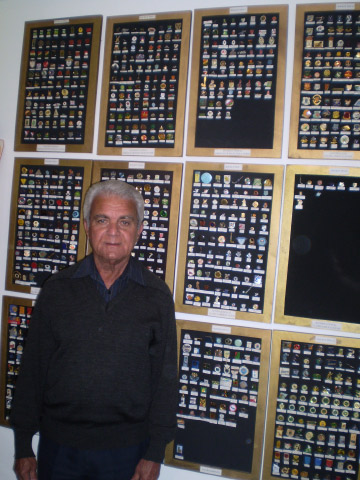
Stan Salazaar with a part of his hockey pin collection
 person
who has a car license plate that states HOCKEY1 has to be a special kind
of hockey fan.
The owner of the car being referenced is Perth-based Stan Salazaar, who
has the largest one-man collection of hockey memorabilia in the world. person
who has a car license plate that states HOCKEY1 has to be a special kind
of hockey fan.
The owner of the car being referenced is Perth-based Stan Salazaar, who
has the largest one-man collection of hockey memorabilia in the world.
Stan's collection, over the course of the past 35 years, comprises hundreds of hockey books, lapel pins/badges,
stamps, program guides and magazines. Stan's books on Indian hockey
include:
| Year |
Book Title |
Pin Description |
| 1952 |
Goal |
Dhyan Chand |
| 1978 |
Olympic Hockey on AstroTurf |
Gian Singh |
| 1982 |
To Hell With Hockey |
Aslam Sher Khan |
| 1984 |
Wills Book of Excellence - Hockey |
Ron Hendricks |
| 1992 |
Dhyan Chand - The Legend Lives On |
Niket Bhushan |
| 1995-99 |
Hockey Year Books (1995, 98, 99) |
Arumugam |
| 2000 |
The Golden Boot |
Kaushik/Arumugam |
Stan is looking for the following books to add to his collection
- Romance of Hockey, by M. L. Kapur (1967)
- Bengal Hockey Association Golden Jubilee: 1908-1958
- The World's Hockey Champions by M. N. Masood.(1937)
- Story of the Olympics by Melville de Mellow
- Hockey in India by W. Troup (1908)
- Cherished Moments with a Stick by John D'Abrew
Stan was born in Akola, while his wife Margaret was born in Bhusaval.
He studied at La Martiniere school in Lucknow. Stan has fond memories
of being coached by K. D. Singh 'Babu' while playing hockey in Uttar
Pradesh. He went to England in 1959 and spent 12 years there, before
settling in Australia.
Hockey Olympians (late) M. K. Kaushik and Merwyn Fernandes have stayed
with Stan in Perth. Stan played veterans hockey for Western Australia in the Australian
Veterans Championship.
Stan says, "I am always on the lookout to add to to my hockey
collection.It is harder these days as there are
not too many hockey books being published, and hockey pins/badges are
even scarcer.I still enjoy hunting around though. I am looking for collectors in the hope
of exchanging my many pins/badges and other duplicates. I can be reached at mars93@bigpond.com."
A sampling of duplicate pins that Stan has is shown below.
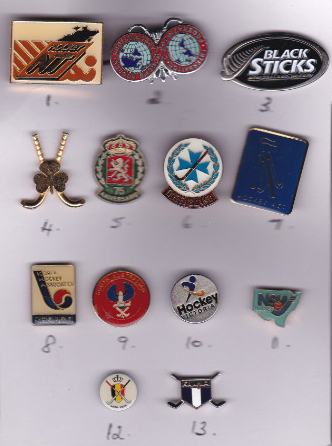 |
Pin No. |
Country |
Pin Description |
| 1 |
Australia |
Northern Territory Hockey Association |
| 2 |
Global |
International Federation of Women's Hockey Association |
| 3 |
New Zealand |
Hockey New Zealand |
| 4 |
United Kingdom |
Wales Women's Hockey Association |
| 5 |
Spain |
Spain Hockey Federation 75th Anniversary |
| 6 |
Australia |
Queensland Hockey Association |
| 7 |
Australia |
Australian Capital Territory Hockey Association |
| 8 |
South Korea |
Korea Hockey Association |
| 9 |
Australia |
South Australia Hockey Association |
| 10 |
Australia |
Hockey Victoria |
| 11 |
Australia |
New South Wales Hockey Association |
| 12 |
Belgium |
Royal Belgium Hockey Association |
| 13 |
Japan |
Keino University Hockey Club |
Stan watched the Tokyo Olympics on television, especially men's
and women's hockey. He had the following to say, "I must
congratulate Japan for putting on a good show despite the lack of
spectators and strict restrictions on the participants.The Indian
men's hockey team did wellt to win a long overdue bronze medal.The
Indian women's team lost their first 3 matches, but finished the
tournament well to come an unlucky fourth.I never gave them a chance
against Australia but they prevailed.Some of the girls have
exceptional skills.The good showing of both teams should hopefuly
give hockey in India a huge boost."
|
| Photograph of the Month |
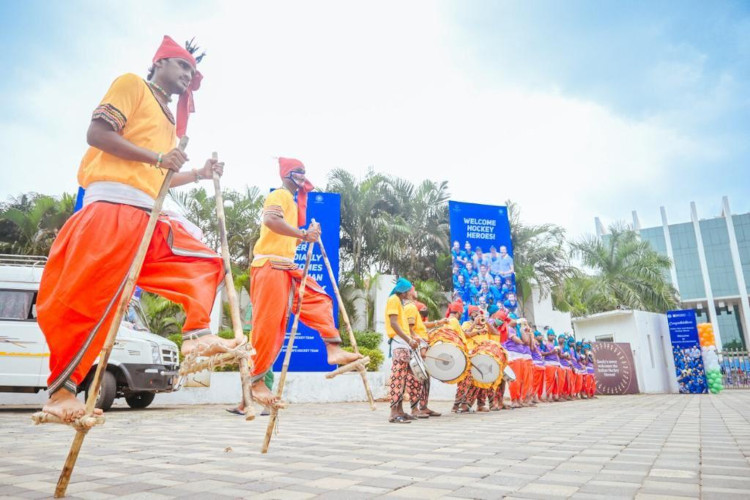
Welcome reception for the Indian men's and women's
Olympic hockey teams at Bhubanesvar
Article by Shantanu
Srivastava of Firstpost, photograph
courtesy Sports Odisha
 he
Photograph of the Month for September 2021 is of a reception to the
Indian men's and women's Olympic hockey teams at Bhubanesvar, after
their successful exploits at the Tokyo 2020 Olympics. he
Photograph of the Month for September 2021 is of a reception to the
Indian men's and women's Olympic hockey teams at Bhubanesvar, after
their successful exploits at the Tokyo 2020 Olympics.
In the words of Vineel Krishna, currently serving the Odisha
government as Secretary Sports and Youth.
"I still remember the day India's men's hockey team won the historic
bronze at Tokyo Olympics. All my staff and most people I know woke up
early and watched the match in their houses, and the only conversation
we had throughout the day revolved around the India-Germany match. More
than the result, I think what captured the attention of people here was
the way India played.
The medal means so much to Odisha, as it does to the rest of the
country. A lot of people are now recognising and appreciating Odisha
government's support for hockey.
We have organised so many top tournaments at the Kalinga Stadium, and
we are always pleasantly surprised to see the crowds turning up in full
capacity for each game. I have witnessed crowds in Kalinga even during
pouring rain. They would just hold their umbrellas and relish the game;
that's the kind of love they have for hockey.
So, in a way, supporting our hockey teams is Chief Minister Naveen
Patnaik's way of honouring people's sentiments and wishes. The idea to
sponsor hockey teams germinated from a very simple and pure emotion - to
support this beautiful game and encourage more people to take up hockey.
On a personal front, the Chief Minister has a special place for hockey
because he played as a goalkeeper in his school days.
Thanks to our men's and women's hockey teams, we have seen something
special in Tokyo. I wish them all the best, and assure them of every
support possible."
|
| Money Matters |
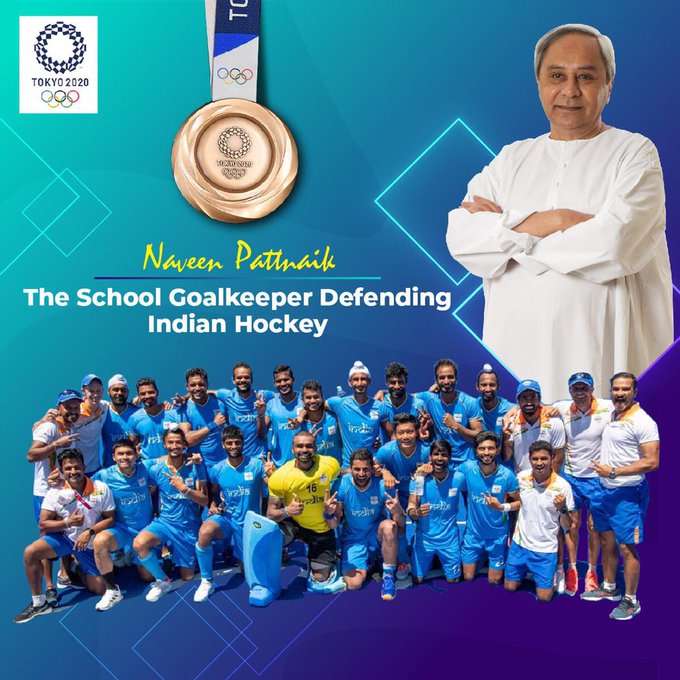
Article by Romita Das,
courtesy India Today
 disha
Chief Minister Naveen Patnaik's tryst with hockey began six decades ago,
when as a student at Doon School, he guarded his team's goalpost as a
goalkeeper. In the past three years, he has been the biggest benefactor
of Indian hockey, lavishing money and resources on the sport. disha
Chief Minister Naveen Patnaik's tryst with hockey began six decades ago,
when as a student at Doon School, he guarded his team's goalpost as a
goalkeeper. In the past three years, he has been the biggest benefactor
of Indian hockey, lavishing money and resources on the sport.
Since 2018, the Odisha government has sponsored both the men's and
women's national hockey teams, stepping in as sponsor when business
group Sahara withdrew. Odisha drew up an agreement under which it agreed
to pay ₹120 crore over five years, with the money going
toward building infrastructure and logistical support. Apart from this,
all expenses of both the teams—for boarding, training, education and
nurturing talent—are borne by the state exchequer. State sports minister
Tusharkanti Behera says Odisha has increased its sports budget (from
which the hockey teams are funded) from ₹265 crore to ₹370 crore
this year.
This is the first time a state has taken the responsibility of
supporting a national team. In 2018, Odisha hosted the Men's Hockey
World Cup at its brand-new Kalinga Stadium. At the time, when asked why
his state was taking responsibility for what the Centre should have been
doing, Patnaik was clear. "Someone has to take responsibility, to spare
embarrassment to the country and the sport."
In 2021, the state will spend ₹190 crore to build 17
astroturf pitches in 17 blocks of Sundargarh district, located about 370
km from Bhubanesvar, and considered the cradle of the game in Odisha.
The government is prioritising developing this infrastructure to ensure
that budding hockey players have an opportunity to familiarise
themselves with it and to learn the tricks of the trade on a pitch
similar to those they will play on in international tournaments.
The state sports academy in Sundargarh identifies budding talent as
young as eight or ten years of age, through school competitions or the
recommendations of games and PT teachers. "School education and mass
education departments are involved in identifying talented players. We
use school playgrounds and school sports teachers for primary level
screening; district sports officers are also there to help," says Behera.
The real training begins once talented players are recruited and sent to
sports hostels, where they receive coaching and education to develop
their physical and mental faculties. Odisha has 16 sports hostels across
15 districts, in addition to a sports academy at Sundargarh, and ten
high-performance centres for various sports, including hockey, to train
budding players. The sports academy houses 1,250 trainees, the majority
of whom are potential players in inter-state, national and international
tournaments and matches.
Once they are ready, they graduate to high performance centres to give
their skills a professional edge, and most importantly, to receive
exposure to professional games. The government opened the
high-performance centre for hockey in collaboration with Tata Trust and
Tata Steel - the Naval Tata Hockey Academy in Bhubanesvar.
By hosting major tournaments in the past five years - including the 2018
World Cup, the 2014 Champions Trophy in 2014, 2017 Hockey World League
Final, 2020 Olympic Qualifiers at the iconic Kalinga Stadium in
Bhubanesvar - the Odisha government ensured that Indian players had a
brush with global talent to get used to world-class tournaments and to
hone their skills. It is also spending ₹110 crore to
build a world class sports stadium at Rourkela for the 2023 Men's Hockey
World Cup.
All this has paid dividends to the hockey-loving chief minister. On
August 5, when the men in blue ensured a bronze for India, breaking a
four-decade-long jinx, an ecstatic Patnaik tweeted: "Brilliant in Blue.
Congratulations Indian Men's Hockey Team on spectacular victory. This
historic win at #Tokyo 2020 will inspire generations of sportspersons.
All the very best for the future. #Cheers4India @hockeyIndia."
|
| Media Matters |
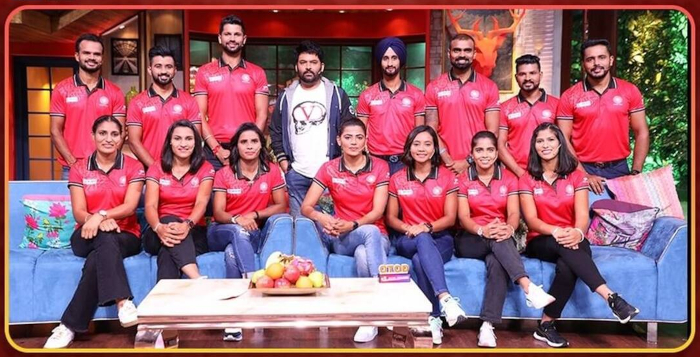
Image courtesy the Kapil Sharma Show on
Sony Entertainment Television
 embers
of India's men's and women's hockey teams graced the Kapil Sharma Show
on Saturday, 28th August. Kapil said that it was an honour and a privilege
to have the two teams, who have made India proud, as his guests on the
show. The audience saw the
fun and hilarious side of Indian hockey players, as they indulged in banter with
host Kapil Sharma, Krushna Abhishek and Bharti Singh. embers
of India's men's and women's hockey teams graced the Kapil Sharma Show
on Saturday, 28th August. Kapil said that it was an honour and a privilege
to have the two teams, who have made India proud, as his guests on the
show. The audience saw the
fun and hilarious side of Indian hockey players, as they indulged in banter with
host Kapil Sharma, Krushna Abhishek and Bharti Singh.
From the women's hockey team, Rani Rampal, Savita Punia, Neha Goyal,
Sushila Chanu, Gurjeet Kaur, Vandana Katariya and Navneet Kaur were seen on the show. From the
men's team, Mandeep Singh, Manpreet Singh, P. R. Sreejesh, Birendra Lakra,
Rupinder Pal Singh, Lalit Kumar Upadhyay and Harmanpreet Singh were the guests.
The men's team recounted their experience of talking to Prime
Minister Narendra Modi after their bronze win at the Olympics. They also talked about
dealing with the language barrier in Japan and other countries.
While pointing out the number of Punjabi team members from both the
hockey teams in attendance, the host jokingly asked them, "Aap apni
marzi se aaye hai ki Sidhuji ne bheja hai? (Did you come on your
own accord, or did the Punjab politician Navjot Singh Sidhu send you to
the show?)"
When Kapil asked Lalit Upadhyay on how he decided to join the sport
instead of studying further. Lalit replied, "Padhai ki baat karein toh
hum bhi utna hi gaye hai college jitna aap gaye hai (I have studied
as much as you)." His hilarious answer left everyone in splits.
The women's team fielded questions on whether they like to wear
makeup or not. One of the players also mimicked Bharti Singh, leaving
her stumped. All the players also danced on the stage with the show's team.
Kapil then got all to burst out in laughter when he asked them
if they have any other dreams, now that they met the
country's Prime Minister and now have met him. Giving
him a fitting reply, a member of the men's hockey team asked him. "Yeh
batao, aapne kabi socha ki hum Olympic medalist yaha pe ayenge (Did
you think you will be hosting Olympic medallists on your show?)"
Tthe host questioned the women players if they felt like wearing makeup while
playing the game at the Tokyo Olympics, as millions were watching them. He then added that
they may not do so because the coach would not recognise them once the makeup fades away because of the heat and sweat.
A special video message from Odisha Chief Minister Naveen Patnaik was played during the
show. The state is the sponsor of the Indian men's and women's hockey teams.
The segment ended with all the players dancing on the stage with The
Kapil Sharma Show's team.
|
| Records and Statistics |
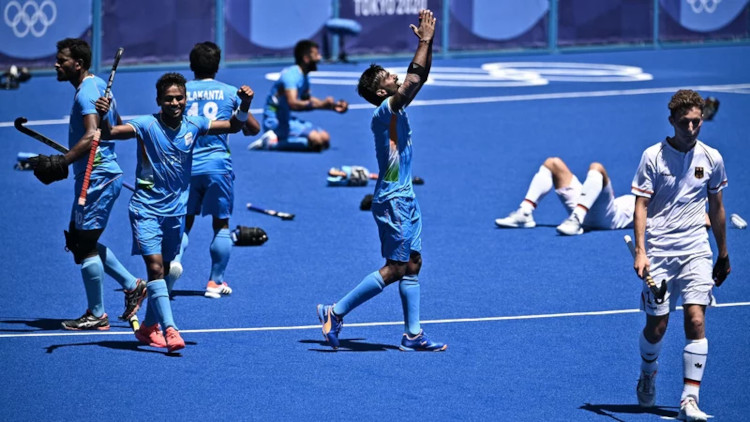
India celebrate their bronze medal win against Germany
in the Tokyo 2020 Olympics. Photograph credit Getty Images
 his
month's edition of records and statistics is on Olympic gold medal winners
in men's and women's hockey, updated after the Tokyo 2020 Olympics his
month's edition of records and statistics is on Olympic gold medal winners
in men's and women's hockey, updated after the Tokyo 2020 Olympics
Olympic Men's Hockey
- India has won the maximum number of medals in Olympic men's hockey
with 12 - 8 Gold, 1 Silver, 3 Bronze
- The team that India beat in the bronze medal match at Tokyo 2020 -
Germany - is in second place with 11 medals in Olympic men's hockey - 4
Gold, 3 Silver, 4 Bronze
- Pakistan's 3 gold medals in Olympic men's hockey (1960, 1968, 1984)
have all followed India's gold medals in the prior Olympics (1956, 1964,
1980)
- England (1908) and Germany (1972) are the only countries to win the
Olympic men's hockey gold on home soil
- New Zealand (1976) and Argentina (2016) have entered the semi-finals
of Olympic men's hockey only once, and went on to win the gold in their
sole appearance
- 2 continents have not won the Gold medal in Olympic men's hockey -
Africa and North America
Olympic Women's Hockey
- Netherlands has won the maximum number of medals in Olympic women's hockey
with 9 - 4 Gold, 2 Silver, 3 Bronze Medals
- In second place is Argentina with 5 medals in Olympic women's hockey
- 0 Gold, 3 Silver, 2 Bronze Medals
- For Australia, it is gold or nothing - they won 3 Gold in Olympic
women's hockey, and no other medal
- Spain (1992) and Australia (2000) are the only countries to win the
Olympic women's hockey gold on home soil
- Zimbabwe participated only once in Olympic women's hockey - 1980 -
and won the gold medal in their sole Olympic appearance
- 3 continents have not won the Gold medal in Olympic women's hockey -
Asia, North America and South America
|
![]()